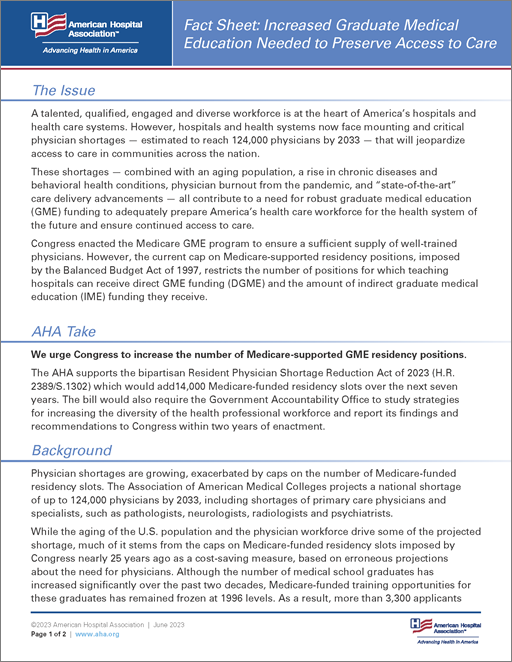

Fact Sheet: Increased Graduate Medical Education Needed to Preserve Access to Care
June 2023
The Issue
A talented, qualified, engaged and diverse workforce is at the heart of America’s hospitals and health care systems. However, hospitals and health systems now face mounting and critical physician shortages — estimated to reach 124,000 physicians by 2033 — that will jeopardize access to care in communities across the nation.
These shortages — combined with an aging population, a rise in chronic diseases and behavioral health conditions, physician burnout from the pandemic, and “state-of-the-art” care delivery advancements — all contribute to a need for robust graduate medical education (GME) funding to adequately prepare America’s health care workforce for the health system of the future and ensure continued access to care.
Congress enacted the Medicare GME program to ensure a sufficient supply of well-trained physicians. However, the current cap on Medicare-supported residency positions, imposed by the Balanced Budget Act of 1997, restricts the number of positions for which teaching hospitals can receive direct GME funding (DGME) and the amount of indirect graduate medical education (IME) funding they receive.
AHA Take
We urge Congress to increase the number of Medicare-supported GME residency positions.
The AHA supports the bipartisan Resident Physician Shortage Reduction Act of 2023 (H.R. 2389/S.1302) which would add14,000 Medicare-funded residency slots over the next seven years. The bill would also require the Government Accountability Office to study strategies for increasing the diversity of the health professional workforce and report its findings and recommendations to Congress within two years of enactment.
Background
Physician shortages are growing, exacerbated by caps on the number of Medicare-funded residency slots. The Association of American Medical Colleges projects a national shortage of up to 124,000 physicians by 2033, including shortages of primary care physicians and specialists, such as pathologists, neurologists, radiologists and psychiatrists.
While the aging of the U.S. population and the physician workforce drive some of the projected shortage, much of it stems from the caps on Medicare-funded residency slots imposed by Congress nearly 25 years ago as a cost-saving measure, based on erroneous projections about the need for physicians. Although the number of medical school graduates has increased significantly over the past two decades, Medicare-funded training opportunities for these graduates has remained frozen at 1996 levels. As a result, more than 3,300 applicants lacked residency slots in 2022.1 Furthermore, the caps have created imbalances that favor allocation of slots toward lower-cost and higher-reimbursement specialties, rather than more urgently needed primary care and behavioral health. While some hospitals are filling in gaps by self- funding a portion of their own, this model is not sustainable over the long haul, as evidenced by the -17.3% Medicare margins (without COVID-19 relief funds) for teaching-only hospitals in 2020.2
Lifting the cap on Medicare-funded residency positions would enhance access to care and help America’s hospitals better meet the needs of the communities they serve. Increasing Medicare-funded residency slots would provide hospitals more flexibility to diversify and maintain training programs, including both primary care and specialty programs. In addition, an increase in slots would allow health systems to train residents in more diverse facility types, such as smaller rural hospitals which may not be able to operate their own training programs. This would benefit both the quality of physician education and the patients they would serve.
- NRMP 2022 Main Residency Match, https://www.nrmp.org/wp-content/uploads/2022/11/2022-Main-Match-Results-and-Data-Final-Revised.pdf.
- July 2022 MedPAC Databook Section 6 Acute Inpatient Services, https://www.medpac.gov/wp-content/uploads/2022/07/July2022_MedPAC_DataBook_Sec6_SEC.pdf.


